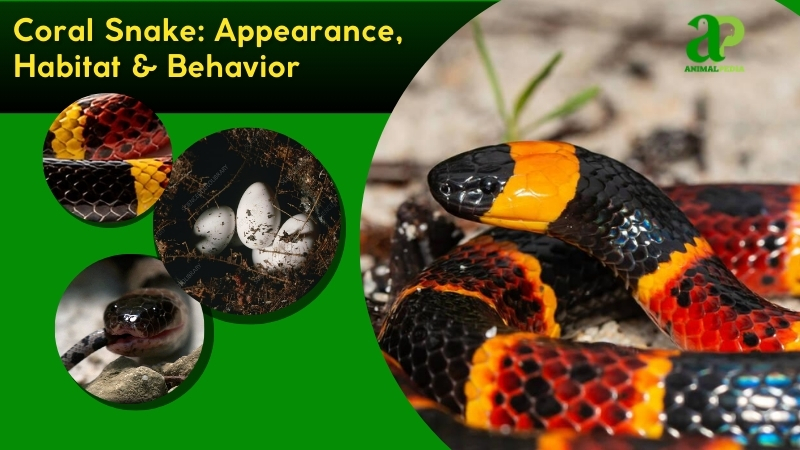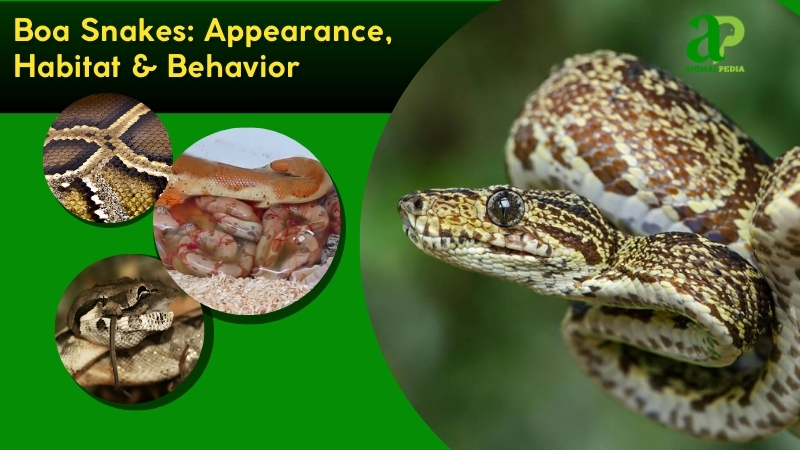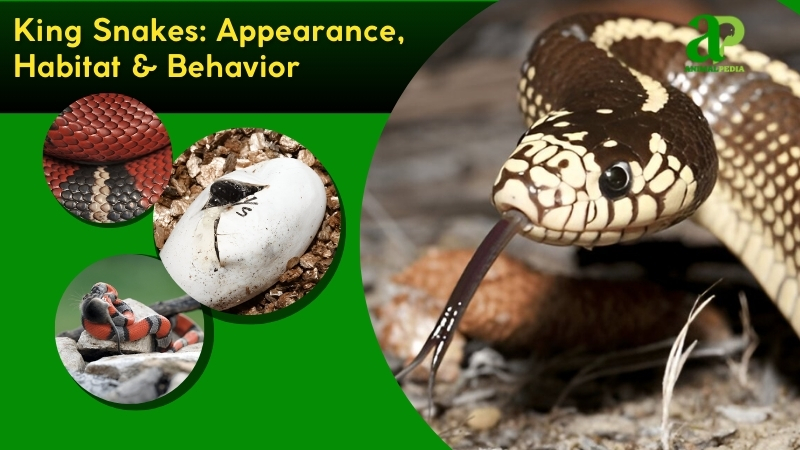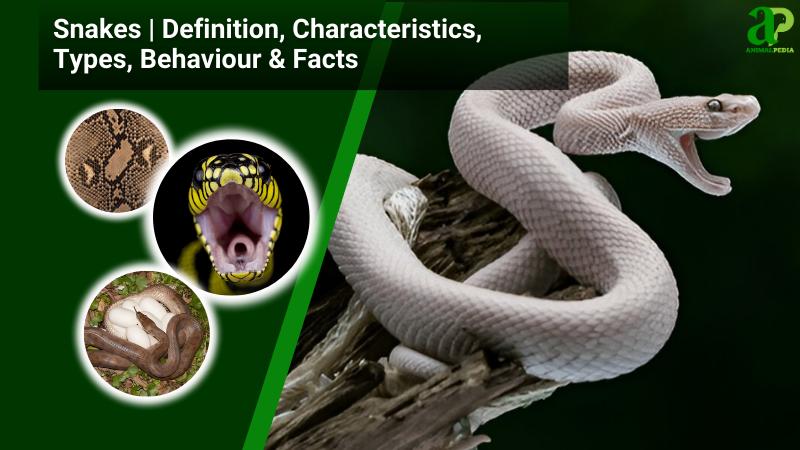Dragon snakes, a singular species known as Xenodermus javanicus or Javan dragon snake, mesmerize with their sleek, iridescent scales. Only one species exists, showcasing a slender form stretching 2-2.6 ft (60-80 cm). Their keeled scales, resembling dragon hide, glimmer under forest light. These elusive reptiles inhabit Southeast Asia’s humid lowlands, particularly Java, Sumatra, and Borneo.
The Javan dragon snake’s distinct morphology sets it apart. Its scientific name reflects its Javan origins. Notable for triangular heads and raised dorsal scales, these snakes thrive in Indonesia’s Sunda Islands, favoring Java’s rainforests. Their key feature—three rows of spiky scales—creates a textured, dragon-like appearance, aiding camouflage in leaf litter.
Ecologically, dragon snakes are not apex predators but adept hunters. Nocturnal and secretive, they move slowly to stalk prey, specializing in amphibians like frogs. Using mild constriction, they subdue meals efficiently. Human encounters are rare due to their reclusive nature, and they pose no threat, though habitat destruction looms as a concern.
Reproduction follows a seasonal rhythm. Mating peaks in the wet months, October to February. Females lay 2-4 eggs in damp soil, with incubation spanning 60-70 days. Hatchlings, about 0.5 ft (15 cm) long, hunt small prey independently. They mature in two years, living 8-10 years in the wild, resilient yet vulnerable to environmental shifts.
This article delves into the dragon snake’s unique traits, habitat preferences, and lifecycle, offering a concise yet vivid portrait. Animal Pedia crafts engaging, accurate content to illuminate this cryptic reptile’s role in Southeast Asian ecosystems.
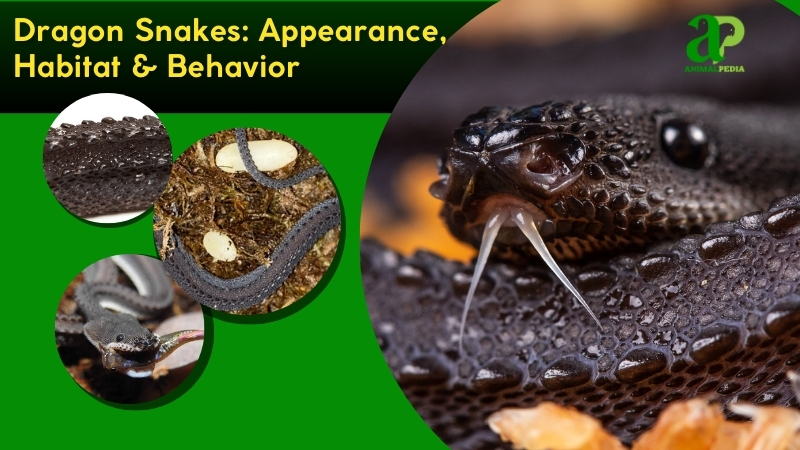
What Do The Dragon Snakes Look Like?
The dragon snake shows a slim, round body with dark gray to black coloration. Its scales shine with a subtle iridescent gleam that changes in light. The rough, keeled scales feel spiky to touch, resembling a dragon’s hide. Its triangular head stands out from the narrow neck, with small, intense eyes featuring vertical pupils, adapted for night hunting.
A forked tongue samples the air for scents. The flexible body displays three distinctive rows of raised dorsal scales – a defining characteristic. It lacks limbs, with a long, tapering tail that enhances movement.
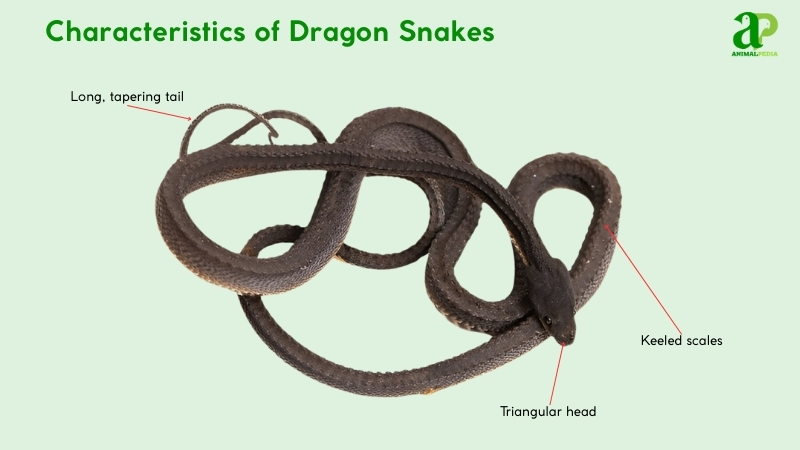
Unlike the Asian vine snake (Ahaetulla prasina), with its smooth scales designed for arboreal life, the dragon snake’s spiky texture excels at ground camouflage among Java’s forest floor debris. Compared to rat snakes (Ptyas mucosa), it features a more angular head with larger facial scales.
How Big Do Dragon Snakes Get?
Dragon snakes (Xenodermus javanicus) average 2-2.6 ft (60-80 cm) in length and weigh 0.2-0.4 lbs (0.1-0.2 kg). These slender reptiles maintain a consistent size across their range in Southeast Asia. Adult dragon snakes typically measure 2.3 ft (70 cm) from snout to tail, with females slightly longer than males. Their lightweight build aids in navigating humid forest floors and rice paddies, ensuring stealth in their nocturnal hunts.
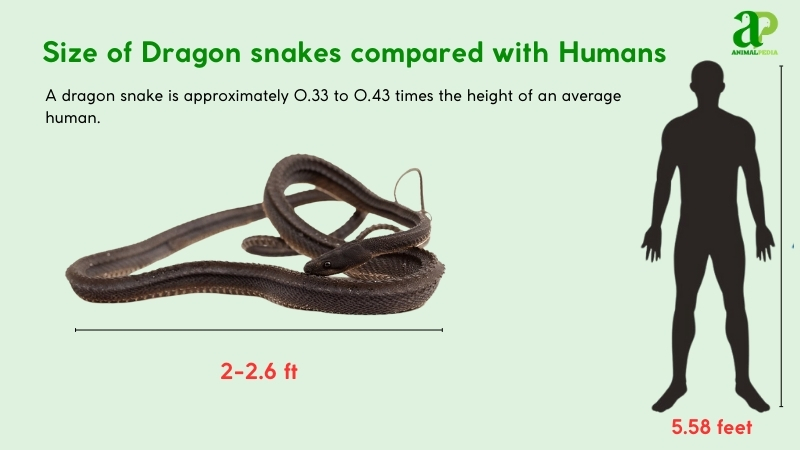
The largest recorded dragon snake reached 2.8 ft (85 cm) and weighed 0.5 lbs (0.23 kg), found in Java, Indonesia, per a 2019 study (Vogel & David, 2019). Males average 2.1 ft (65 cm) and 0.2 lbs (0.1 kg), while females hit 2.5 ft (75 cm) and 0.3 lbs (0.15 kg). The table below highlights these differences.
| Sex | Length (ft/cm) | Weight (lbs/kg) |
| Male | 2.1 (65) | 0.2 (0.1) |
| Female | 2.5 (75) | 0.3 (0.15) |
Their elegant appearance and behavior truly make them a fascinating species to admire and study in the wild.
What Are The Unique Physical Characteristics Of Dragon Snakes?
The dragon snake displays unique dorsal morphology unmatched in ophidian species: three rows of elevated, keeled scales. These ridges form a distinctive dragon-like crest along its spine, providing exceptional camouflage in Southeast Asian forest debris. This specialized scale structure, found only in the genus Xenodermus, distinguishes it from other colubrids and represents an adaptation to moist habitats, including Javanese lowland regions.
The scales create visual disruption against aerial predators and exhibit a subtle iridescence that shifts with light conditions. This characteristic stands in stark contrast to similar-sized species, such as the common rat snake (Ptyas mucosa), which exhibit conventional smooth scales. The dragon snake’s distinctive features represent perfect evolutionary alignment with its ecological niche.
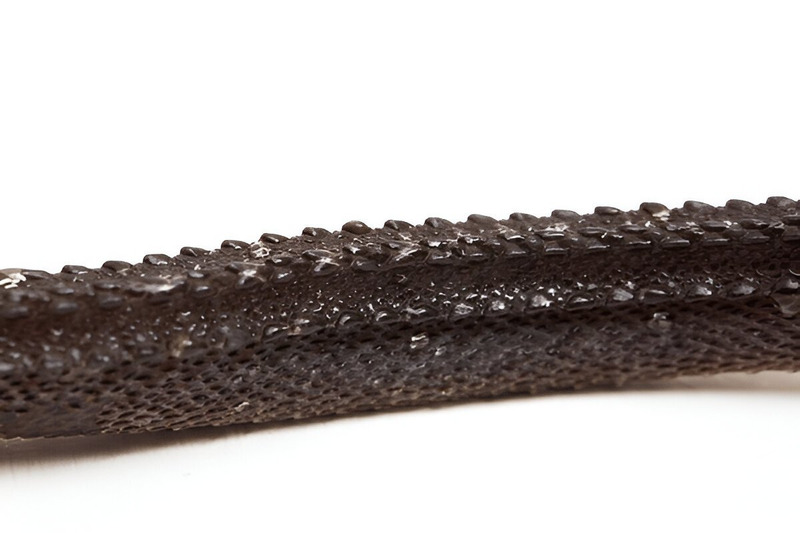
Anatomy
The dragon snake shows anatomical adaptations. These features enable survival in Southeast Asia’s humid forests, supporting its secretive lifestyle and night hunting.
- Respiratory System: The snake has asymmetric lungs, with the right lung larger and more developed. Air enters through the glottis, enabling efficient oxygen uptake during slow-paced hunts in Java’s dense understory.
- Circulatory System: A three-chambered heart (two atria, one ventricle) circulates blood effectively. This compact cardiovascular arrangement supports the snake’s minimal energy expenditure and lightweight frame of approximately 0.3 pounds.
- Digestive System: An elongated esophagus and specialized stomach process amphibians, particularly frogs. Powerful digestive enzymes and acids break down prey completely, maximizing nutrient absorption for this small predator.
- Excretory System: Efficient kidneys convert waste into uric acid, preserving water. This adaptation suits its moist habitat, reducing water loss as it inhabits rice paddies and forest floors.
- Nervous System: A streamlined brain coordinates with specialized sensory organs. Vertical pupils enhance dim-light vision, while highly sensitive skin detects subtle vibrations, enabling precise strike accuracy in the dark.
These integrated biological systems make the dragon snake a specialized ambush predator. Its anatomy represents perfect adaptation to humid tropical ecosystems, where stealth and efficiency determine survival.
Where Do Dragon Snakes Live?
Dragon snakes inhabit Southeast Asia, primarily in Indonesia’s Sunda Islands—Java, Sumatra, and Borneo. Java’s lowland rainforests and rice paddies support thriving populations, while Sumatra’s peat swamps serve as vital habitats.
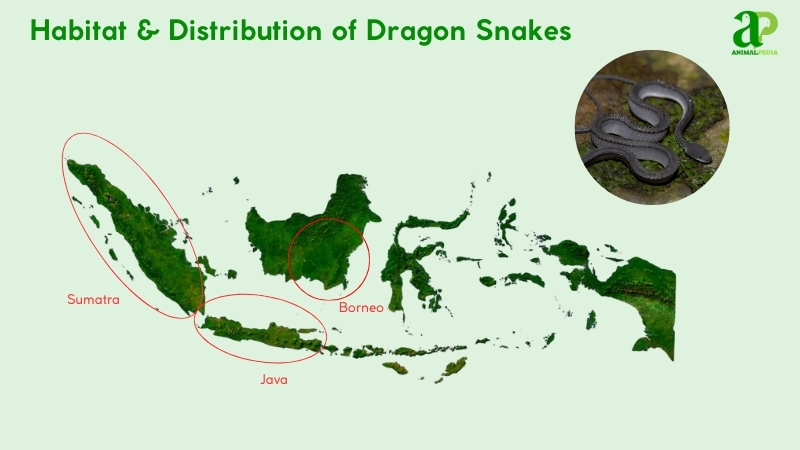
Their environment stays warm and wet, perfect for their nocturnal behavior. They require 70-90% humidity and dense vegetation that conceals their distinctive spiky scales. They hide in leaf litter and mud to avoid avian predators. These reptiles feed mainly on amphibians that abound in these ecosystems. They don’t migrate, but they are stable habitats year-round.
Research by Vogel & David (2019) confirms these Xenodermidae family members have occupied these regions for centuries, their survival linked to specific ecological conditions that support their secretive lifestyle and specialized adaptations.
How Do Seasonal Changes Affect Their Behavior?
Dragon snakes exhibit behavioral adaptations across two seasons in Southeast Asia: wet (October-February) and dry (March-September). These shifts shape their survival in humid habitats.
- Wet Season (October-February)
Increased activity drives mating and hunting. Abundant frogs prompt frequent nocturnal stalks, while females lay 2-4 eggs in moist soil, capitalizing on high humidity.
- Dry Season (March-September)
Reduced activity conserves energy. Dragon snakes retreat to leaf litter, minimizing hunts due to scarcer prey, focusing on hydration in drier forests.
What Is The Behavior Of Dragon Snakes?
The Dragon Snake has distinct traits and behaviors as follows:
- Diet: Strictly carnivorous, feeding mostly on frogs, tadpoles, and small fish. Diet shifts with age; hatchlings eat tadpoles, while adults hunt medium-sized frogs, especially in Southeast Asia’s rice paddies.
- Hunting Mechanisms: Nocturnal ambush predators use stealth, smell, and camouflage. They strike quickly and use mild constriction to subdue prey, relying on precision and patience.
- Daily Activity Patterns: Nocturnal; active at night to hunt and avoid predators. During the day, they hide in leaf litter or wet forest areas to conserve energy and stay protected.
- Locomotion Capabilities: Slithers smoothly on land and glides effortlessly in water with a streamlined body. Well-adapted for life in humid forests and marshes.
- Social Structure: Solitary creatures that live and hunt alone. Most active at night, they rarely interact outside of mating.
- Communication: Communicates through body language, such as stiffening when threatened. Uses scent and subtle cues to signal presence or danger.
Dragon snakes’ unique hunting style, solitary nature, and nocturnal habits reflect their adaptability to Southeast Asia’s forested wetlands.
What Do Dragon Snakes Eat?
Dragon snakes are strict carnivores, favoring amphibians, especially frogs as their primary prey in Southeast Asia’s humid forests. Being non-venomous, they never attack humans, preferring stealth over confrontation.
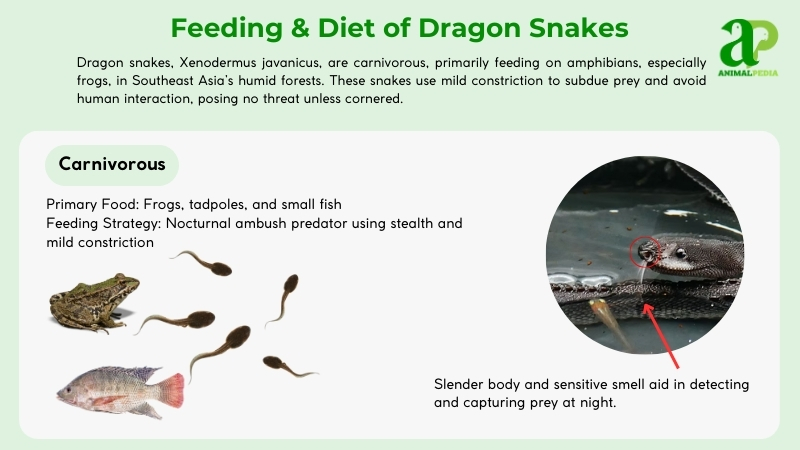
- Diet by Age
Diet evolves with age to meet energy demands. Hatchlings (0–6 months) feed on tiny frogs and tadpoles, which are easily subdued for rapid growth. Juveniles (6 months–1 year) target small adult frogs, honing hunting skills. Subadults (1–2 years) pursue larger frogs, refining constriction techniques. Adults (2+ years) focus on medium-sized frogs, efficiently consuming abundant prey in Java’s rice paddies.
- Diet by Gender
Males and females share identical diets and target frogs with equal precision. Both use mild constriction and swallow prey whole, showing no dietary differences.
- Diet by Seasons
Seasonal changes shift feeding patterns. In the wet season (October–February), abundant frogs fuel frequent hunts. In the dry season (March–September), scarcer prey reduces feeding, with snakes conserving energy in leaf litter.
How Do Dragon Snakes Hunt Their Prey?
Dragon snakes hunt with silent precision in their aquatic domains. These nocturnal reptiles use their keen olfactory senses and cryptic coloration to locate amphibians, fish fry, and aquatic invertebrates. They strike with explosive speed, capturing prey before escape is possible.

Their hydrodynamic physique and fluid locomotion enable them to navigate water with minimal disturbance. When targeting prey, Xenodermus javanicus – their scientific name – employs calculated attacks refined through evolutionary adaptation.
Ambush predation defines their hunting strategy. These specialized ophidians merge with their surroundings, motionless until the perfect strike moment arrives-a patient tactic shared by unrelated masters of camouflage, such as the forest-dwelling Timber Rattlesnake species. Their aquatic stealth, silent approach, and crepuscular habits create an effective predatory system. Dragon snakes exemplify evolutionary perfection in their niche – balancing patience with explosive action in wetland ecosystems.
Are Dragon Snakes Venomous?
Dragon Snakes lack venom. Despite their intimidating name and appearance, these reptiles pose no toxic threat to humans. Instead of venom, they rely on alternative defensive strategies.
When threatened, Dragon Snakes display a behavior: they stiffen their entire bodies as a protective response. This distinctive defense mechanism helps them survive in their natural habitats across Southeast Asia.
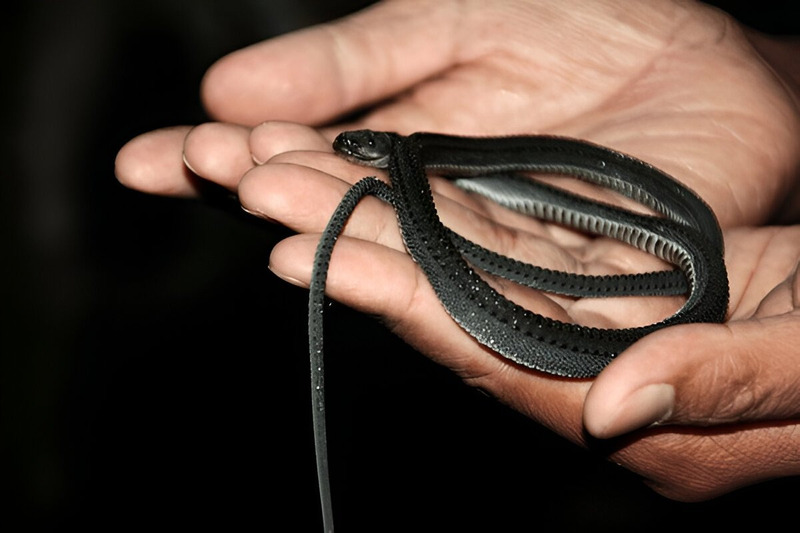
Their keeled scales give them a unique, dragon-like appearance that distinguishes them from other colubrid species. The Xenodermus javanicus (scientific name for Dragon Snake) fascinates herpetologists with its non-venomous nature, which sets it apart from toxic snakes like vipers and elapids.
If you encounter a Dragon Snake in the wild, you can safely observe this nocturnal reptile without concern for envenomation. Their harmless nature makes them intriguing subjects for wildlife enthusiasts and researchers studying defensive adaptations in non-venomous snake species.
When Are Dragon Snakes Most Active During The Day?
Dragon Snakes are primarily nocturnal creatures, resting in their hideouts during daylight hours. They conserve energy during the day, preparing for their nighttime hunting activities when they pursue prey such as frogs, tadpoles, and small fish. Their after-dark behavior serves a dual purpose: avoiding predators and leveraging the darkness to ambush prey effectively.
While appearing inactive during sunlight hours, these serpents transform at dusk. As darkness falls, Dragon Snakes emerge from their shelters, displaying their distinctive behaviors and traits. The moonlit hours mark their peak activity period, when these reptiles are most mobile and engaged in essential survival behaviors such as feeding and territorial patrols.
How Do Dragon Snakes Move On Land And Water?
Dragon Snakes move distinctly on land and in water. On land, they employ lateral undulation, pushing against surface irregularities with their scaled bodies. Their ventral scutes provide traction as they navigate forest floors and marshy terrain with efficiency rather than grace.
In aquatic environments, Dragon Snakes (Xenodermus javanicus) utilize serpentine locomotion, moving with lateral body waves that generate thrust. Their laterally compressed bodies enhance swimming performance, while their keeled scales reduce drag. These reptiles don’t merely swim; they implement specialized axial movements optimized for aquatic propulsion.
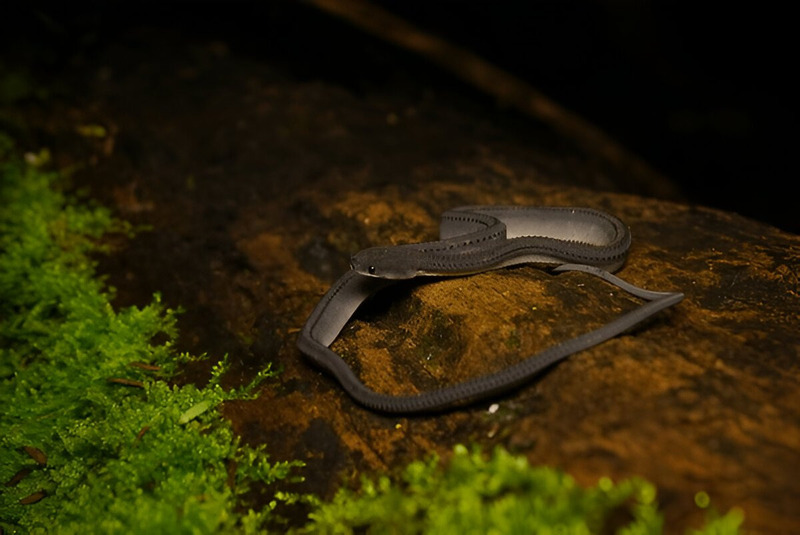
The habitat transition between terrestrial and aquatic environments demonstrates their evolutionary adaptations. Dragon Snakes switch locomotion modes seamlessly, employing different muscle groups and body positions when moving between substrates. This behavioral plasticity represents a key survival mechanism in their native Southeast Asian habitats.
Their locomotor versatility between media reflects specialized morphological adaptations developed over millennia. The biomechanics of Dragon Snake movement illustrate fundamental principles of reptilian locomotion, with its sinusoidal patterns providing efficient energy use in both environments —a characteristic shared with other semi-aquatic serpents in the Colubridae family.
Do Dragon Snakes Live Alone Or In Groups?
Dragon Snakes live alone. These reptiles thrive in solitude, hunting and surviving independently in wet habitats near water sources. Nocturnal predators, they emerge at night to catch frogs, tadpoles, and small fish without company or assistance.
When threatened, Dragon Snakes (Xenodermus javanicus) display a distinctive defensive behavior—they stiffen their bodies rather than seeking safety in numbers. This self-reliance mechanism helps them survive without group protection.
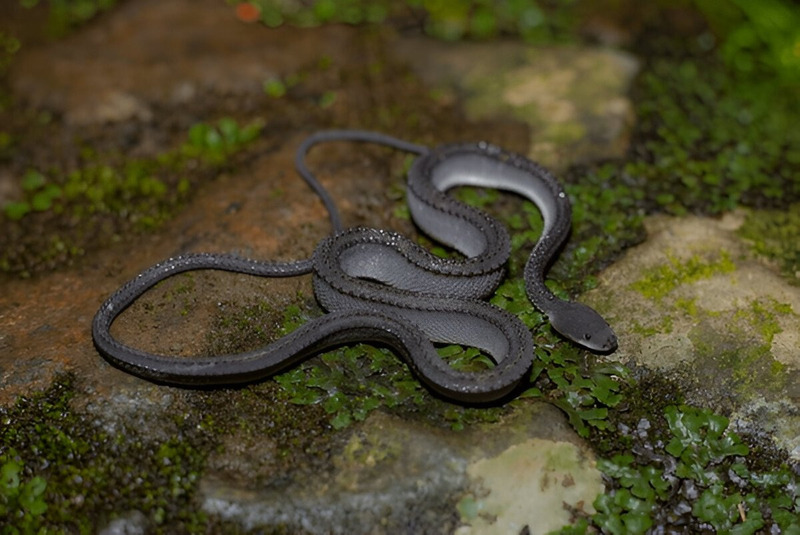
Their solitary lifestyle defines their ecological niche, allowing these serpents to move freely through marshes and forests. Encounters with Dragon Snakes almost always involve single specimens, each navigating its territory alone in the darkness. The independent nature of these reptiles contributes significantly to their reputation as elusive among herpetologists and wildlife observers.
How Do Dragon Snakes Communicate With Each Other?
Dragon Snakes communicate through clear non-verbal signals and chemical markers. They use body postures, movements, and pheromones to exchange crucial information with others of their species.
When threatened, these serpents stiffen their bodies completely—a deliberate warning signal to predators or nearby snakes. They also release distinctive musk that serves dual purposes: deterring threats and communicating with other snakes in their vicinity.
Though they make no sounds, Xenodermus javanicus (the scientific name for Dragon Snakes) have developed highly effective communication methods suited to their environments. Their keen sensory perception allows them to interpret subtle environmental cues and interact with conspecifics through a sophisticated silent language of chemical signals and physical displays that evolved specifically for their nocturnal, semi-aquatic lifestyle.
How Do Dragon Snakes Reproduce?
Dragon snakes reproduce by laying eggs, a process called oviparous reproduction, in their native Southeast Asian humid forests. Their breeding cycles respond directly to environmental conditions.
Reproduction occurs during the wet season from October to February. Males locate females through chemical signals and engage in a simple courtship ritual. They coil around females without elaborate displays. The interaction brief, with males releasing pheromones to communicate readiness. Mating lasts several hours in Java’s dense lowland habitats, ensuring successful fertilization.
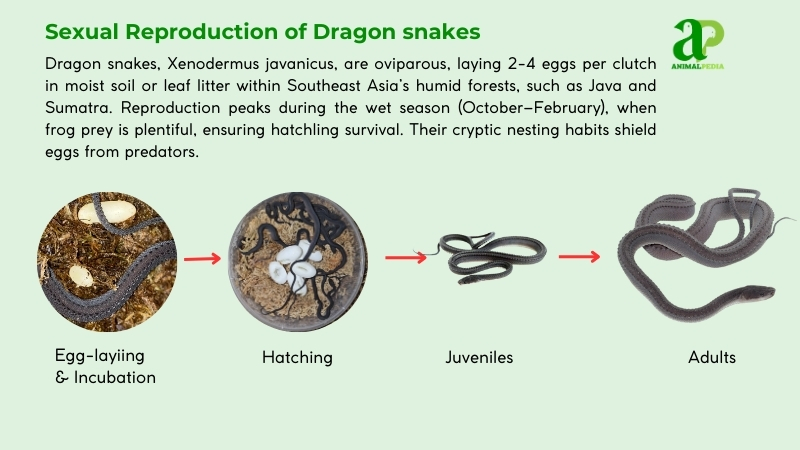
After successful copulation, females deposit 2-4 eggs weighing approximately 0.02 pounds (10 grams) each. They bury these eggs in damp soil or decaying vegetation, utilizing natural humidity for incubation. Neither parent guards the nest after egg deposition. Environmental disruptions, particularly flooding during intense El Niño rainfall patterns, can destroy egg clutches (Das, 2015).
Incubation lasts 60-70 days. The hatchlings emerge at 0.5 feet (15 cm) long, immediately self-sufficient and capable of hunting small amphibians. These juvenile snakes grow steadily and reach sexual maturity within 2 years. Wild dragon snakes typically live 8-10 years. Their secretive nature limits predation, but habitat destruction increasingly threatens their reproductive success, highlighting conservation imperatives.
How Long Do Dragon Snakes Live?
Dragon snakes live 5 to 10 years in their natural habitats. These rare Xenodermus javanicus specimens lay eggs with limited fertility, producing small clutches of 2 to 4 eggs per reproductive cycle. Their unique reproductive patterns ensure the survival of the species despite their vulnerable conservation status.
In wild environments, dragon snakes exhibit distinctive morphological features that fascinate herpetologists. Their keeled dorsal scales and defensive thanatosis behavior (stiffening when threatened) make them subjects for study. These nocturnal reptiles primarily consume amphibians, specifically frogs, tadpoles, and small aquatic vertebrates within their native Southeast Asian wetland ecosystems.
What Are The Threats Or Predators That Dragon Snakes Face Today?
Dragon snakes face serious threats in their native habitats. Their secretive lifestyle makes population monitoring difficult, but clear dangers threaten their existence.
- Habitat destruction ranks as their greatest threat. Widespread clearing of Southeast Asian wetlands and forests for palm oil plantations and urban development eliminates crucial breeding sites. A 2019 Biodiversity and Conservation study directly links this wetland loss to declining reptile populations, including Xenodermus javanicus.
- Water pollution devastates these moisture-dependent reptiles. Agricultural pesticides and industrial discharges poison aquatic ecosystems, compromising reproduction and immune function. This contamination creates cascading effects throughout their food web.
- Climate disruption alters rainfall patterns, which are critical to these specialized reptiles. Rising temperatures and unpredictable precipitation affect the availability of their prey and their hibernation cycles. These changes may eventually render their microhabitats uninhabitable.
- The exotic pet trade creates additional pressure. Despite their challenging husbandry requirements, dragon snakes appear in wildlife trafficking networks. Social media platforms have intensified collection pressure on these already vulnerable colubrids.
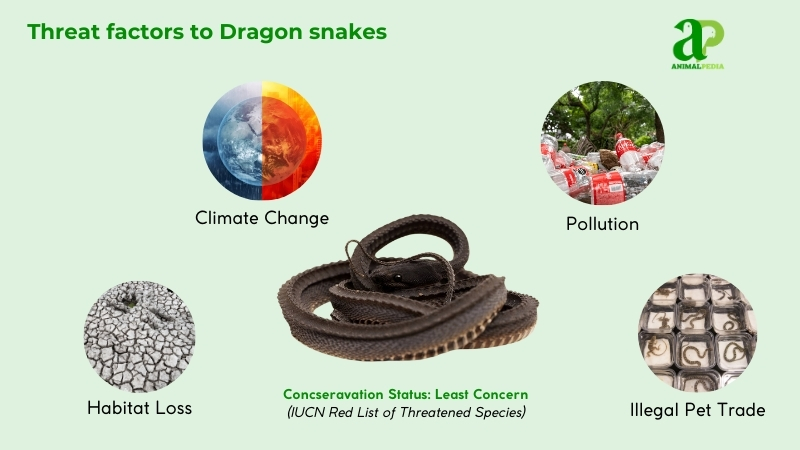
Natural predators include raptors, such as hawks, that target juvenile specimens, and larger ophidians, such as pythons. Mammalian carnivores—particularly civets and mongooses—occasionally hunt adult dragon snakes. Their nocturnal habits and burrowing behavior provide partial protection from these native predators.
Conservation efforts are insufficient due to limited research on this cryptic species. Effective protection requires both habitat preservation and stronger enforcement against illegal collection to ensure that Xenodermus populations are viable within their natural range.
To better understand this species, it’s important to know what does squamata means in zoological terms
Are Dragon Snakes Endangered?
Dragon snakes are listed as Least Concern. The IUCN Red List confirms they face low extinction risk. These reptiles adapt well to human-modified habitats, including agricultural ecosystems and wetlands, maintaining stable populations across their range.
Research on dragon snake populations is limited. Their nocturnal and semi-fossorial habits make field studies challenging. While precise global counts don’t exist, local observations indicate healthy numbers in Southeast Asia, particularly in Java, Indonesia.
A 2019 Biodiversity and Conservation study highlights that while wetland reptiles in Southeast Asia face habitat fragmentation pressures, dragon snakes show ecological resilience. They thrive in rice paddies and marshlands, adapting to landscape changes. Still, environmental toxins and wildlife trafficking pose emerging threats. Though not requiring urgent protection measures, ongoing population monitoring is crucial as climate change and habitat conversion accelerate in their native range.
What Conservation Efforts Are Underway?
Dragon snake conservation is limited due to their Least Concern status on the IUCN Red List. Their stable population across Southeast Asia hasn’t triggered targeted protection programs. Since 2015, the Southeast Asia Reptile Conservation Alliance (SARCA) has protected wetlands in Indonesia and Malaysia where these serpents thrive. These initiatives focus on saving marshes and forests from deforestation through 2025.
Legal frameworks offer indirect protection. Indonesia’s Wildlife Protection Act of 2019 restricts habitat destruction in Java, banning unpermitted land conversion. Malaysia’s Wildlife Conservation Act 2016 combats illegal reptile trafficking, though enforcement varies regionally. These regulations shield dragon snakes by preserving their ecosystems rather than targeting the species directly.
Captive breeding faces significant challenges. Dragon snakes rarely survive in artificial environments. Herpetologists at Bogor Zoology Museum attempted breeding in 2019 by simulating monsoon conditions. Their work produced five eggs, but no hatchlings survived, highlighting the species’ environmental sensitivity. A rare success came in 2022, when a Thai breeder produced four eggs, two of which were viable—an uncommon achievement in xenodermid husbandry.
SARCA and regional academic institutions monitor wild populations, prioritizing habitat conservation over direct intervention. While major conservation victories are elusive, these collaborative efforts help maintain Xenodermus javanicus’s resilience against emerging threats, including wetland pollution and pressure from the exotic pet trade.
Frequently Asked Questions
What Is The Unique Defense Mechanism Of Dragon Snakes?
When threatened, dragon snakes stiffen their bodies as a unique defense mechanism. This technique helps them ward off danger. In addition, they may emit a musky odor as another line of defense. These behaviors showcase their fascinating survival adaptations.
How Many Eggs Do Dragon Snakes Typically Lay?
You’ll find that dragon snakes typically lay 2–4 eggs, which indicates low fecundity. This species exhibits a peculiar defense mechanism: when threatened, it stiffens its entire body and emits a musky odor.
What Is The Unusual Chromosomal Number Of Dragon Snakes?
You’ll find that dragon snakes have an unusual chromosomal number of 2n = 32, which is different from the typical 2n = 36 in most snakes. This unique genetic trait sets them apart.
Do Dragon Snakes Emit Any Specific Odors When Threatened?
When threatened, dragon snakes emit a foul-smelling odor as a defense mechanism. This smell, known as musk, helps deter predators. Their behavior includes stiffening their bodies in response to perceived threats, showcasing their unique defensive tactics.
Are Dragon Snakes More Commonly Found In Specific Elevations In Their Habitat?
In their habitat, dragon snakes are commonly found at varying elevations. They dwell in places such as forests, marshes, and rice fields. Dragon snakes prefer damp areas near water, with elevations typically ranging from 500 to 1,100 meters above sea level.
Conclusion
Dragon Snakes inhabit specialized ecological niches with adaptations. Their sinuous morphology and specialized scales enable efficient aquatic locomotion through swamps and wetlands. While intimidating in appearance, these serpents represent significant biodiversity within the Xenodermidae taxonomic group.
Their behavioral plasticity and unique hydrophilic adaptations make them exceptional subjects for herpetological research. The species demonstrates thermoregulation and predatory techniques specific to their semi-aquatic lifestyle.
Conservation efforts must prioritize these habitat specialists, as wetland degradation threatens their populations. Understanding Dragon Snake physiology and ecological requirements contributes valuable insights to reptilian evolutionary biology and ecosystem dynamics.
Approach these creatures with appropriate caution and scientific appreciation—their existence illustrates the sophisticated evolutionary pathways of specialized reptilian fauna.





